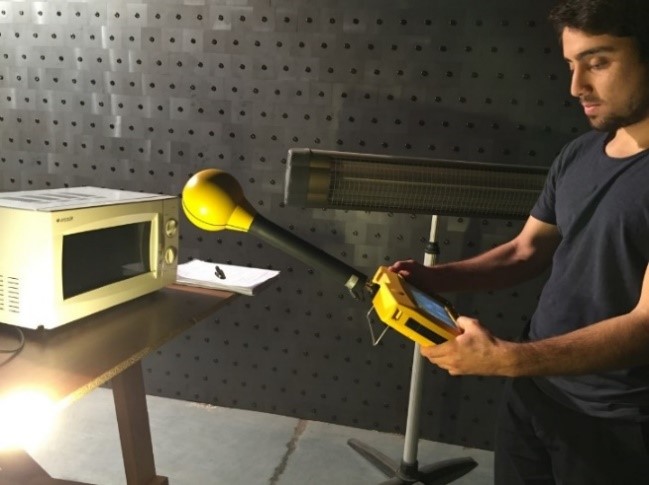Electromagnetic High-Frequency Transients Measurements of Some Household Devices
DOI:
https://doi.org/10.46604/emsi.2023.12005Keywords:
electromagnetic frequencies, dirty electricity, household devices, electromagnetic pollution, human bodyAbstract
Voltage Transients are generated in power lines and emit both low-frequency electromagnetic fields and radio-frequency radiation. This study aims to highlight its existence and detrimental effects on human health. A comprehensive literature review is presented, encompassing studies by multiple authors exploring the topic of dirty electricity, its impact on well-being, and preventative measures. The electromagnetic spectrum analysis and measurements of both electric and magnetic fields are performed on various household appliances such as hair dryers, old televisions, blenders, heaters, toasters, vacuum cleaners, and microwaves. The findings indicates that microwaves and compact fluorescent lamps (CFL) bulbs exhibit similar spectral characteristics, with high-frequency voltage transients primarily originating from these two devices. Conversely, other appliances do not generate significant high-frequency voltage transients (HFVT). Overall, dirty electricity poses a substantial risk to human health and necessitates attention to minimize its adverse consequences.
References
A. B. S. Nzao, “Analysis, Sources and Study of the Biological Consequences of Electromagnetic Pollution,” Open Journal of Applied Sciences, vol. 12, no. 12, pp. 2096-2123, December 2022.
V. Šinik, Ž. Despotović, S. Ketin, and Una Marčeta, “Radiation Of Electromagnetic Fields of Industrial Frequencies. Electromagnetic Radiation Of Electrical Appliances In Households,” EPI International Journal of Engineering, August 2020.
S. J. Genuis, “Fielding a Current Idea: Exploring the Public Health Impact of Electromagnetic Radiation,” Public Health, vol. 122, no. 2, pp. 113-124, February 2008.
L. Hardell and C. Sage, “Biological Effects from Electromagnetic Field Exposure and Public Exposure Standards,” Biomed & Pharmacother, vol. 62, no. 2, pp. 104-109, February 2008.
M. Havas, “Dirty Electricity Elevates Blood Sugar among Electrically Sensitive Diabetics and May Explain Brittle Diabetes,” Electromagnetic Biology and Medicine, vol. 27, no. 2, pp. 135-146, July 2009.
O. Johansson, “Electrohypersensitivity: State-of-the-Art of a Functional Impairment,” Electromagnetic Biology and Medicine, vol. 25, no. 4, pp. 245-258, July 2009.
P. Levallois, “Hypersensitivity of Human Subjects to Environmental Electric and Magnetic Field Exposure: A Review of the Literature,” Environmental Health Perspectives, vol. 110, no. 4, pp. 613-618, August 2002
M. Maslanyj, J. Simpson, E. Roman, and J. Schüz, “Power Frequency Magnetic Fields and Risk of Childhood Leukaemia: Misclassification of Exposure from the Use of the ‘Distance from Power Line’ Exposure Surrogate,” Bioelectromagnetics, vol. 30, no. 3, pp. 183-188, April 2009.
S. Milham and L. L. Morgan, “A New Electromagnetic Exposure Metric: High Frequency Voltage Transients Associated with Increased Cancer Incidence in Teachers in a California School,” American Journal of Industrial Medicine, vol. 51, no. 8, pp. 579-586, August 2008.
S. Milham, Dirty Electricity Electrification and the Diseases of Civilization, 2nd ed., Bloomington: iUniverse, 2012.
M. Segell, “Is Dirty Electricity Making You Sick?” https://www.prevention.com/life/a20460660/electromagnetic-fields-and-your-health/, November 04, 2011.
Greenwave International, “The Dirty Electricity Story,” https://greenwavefilters.com/wp-content/uploads/2014/10/GW-The-Dirty-Electricity-Story-.pdf, October 2014.
M. Havas, “Electromagnetic Hygiene in 12 Easy Steps: How to Create A Cleaner Electromagnetic Environment at Home and at Work,” https://magdahavas.com/, April 03, 2004.
J. Schüz, S. Lagorio, and F. Bersani, “Electromagnetic Fields and Epidemiology: An Overview Inspired by the Fourth Course at the International School of Bioelectromagnetics,” Bio Electro Magnetics, vol. 30, no. 7, pp. 511-524, October 2009.
M. Havas and D. Stetzer, “Dirty Electricity and Electrical Hypersensitivity: Five Case Studies,” World Health Organization Workshop on Electricity Hypersensitivity, Prague, Czech Republic, October 25-26, 2004.
M. Havas, M. Illiatovitch, and C. Proctor “Teacher and Student Response to the Removal of Dirty Electricity by the Graham/Stetzer Filter at Willow Wood School in Toronto, Canada,” 3rd International Workshop, Biological Effects of EMFs, pp. 311-317, Technical Report HPA-RPD-010, October, 2004.
N. Irvine, “Definition, Epidemiology and Management of Electrical Sensitivity,” Radiation Protection Division of the Health Protection Agency, October 2005.
S. S. Seker and O. Simsek, “Brief Review of Biological Effects of Electromagnetic Pollution (RF and 5G Waves) on Humans, Animals, and Vegetation,” International Journal of Innovative Research in Science Engineering and Technology, vol. 11, no. 12, pp. 14201-14214, December 2022.

Published
How to Cite
Issue
Section
License
Copyright (c) 2023 Saban Selim Seker, Osman Cerezci, Muhammet Fatih Bayindir, Ozlem Simsek

This work is licensed under a Creative Commons Attribution-NonCommercial 4.0 International License.
Copyright Notice
Submission of a manuscript implies: that the work described has not been published before that it is not under consideration for publication elsewhere; that if and when the manuscript is accepted for publication. Authors can retain copyright in their articles with no restrictions. Also, author can post the final, peer-reviewed manuscript version (postprint) to any repository or website.
Since Sep. 01, 2023, EMSI will publish new articles with Creative Commons Attribution Non-Commercial License, under Creative Commons Attribution Non-Commercial 4.0 International (CC BY-NC 4.0) License.
The Creative Commons Attribution Non-Commercial (CC-BY-NC) License permits use, distribution and reproduction in any medium, provided the original work is properly cited and is not used for commercial purposes.





